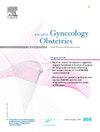Robot-assisted myomectomy versus open surgery: Cost-effectiveness analysis
IF 1.6
4区 医学
Q3 OBSTETRICS & GYNECOLOGY
Journal of gynecology obstetrics and human reproduction
Pub Date : 2024-12-19
DOI:10.1016/j.jogoh.2024.102887
引用次数: 0
Abstract
Introduction
Fibroids are the most common benign uterine tumors. There are different possibilities for surgical approaches, and evaluating the cost of these operations is fundamental in modern surgery. The aim of our study is to evaluate the cost-effectiveness of robotic-assisted myomectomy (RAM) compared to open myomectomy (OM) in France.
Materials and methods
This is an original, retrospective cost analysis and cost-effectiveness comparison between RAM and OM. Women aged >18 years who had undergone myomectomy for large (>8 cm) or multiple (3–5) fibroids via RAM or OM were included from three French hospitals. Confounding factors were controlled using inverse probability of treatment weighting. Costs and major operative complications were assessed one month post-surgery for both groups. The cost per major operative complication (defined as intraoperative and/or postoperative transfusions and/or intraoperative blood loss ≥500 mL) averted was calculated. The incremental cost-effectiveness ratio was determined by dividing the difference in costs by the difference in complications. Uncertainty was explored through probabilistic and deterministic sensitivity analyses. Other complications were also compared between the two groups.
Results
33 womens were operate by RAM and 66 by OM. A statistically non-significant reduction in intraoperative and/or postoperative transfusions and/or intraoperative blood loss ≥ 500 mL will be in favor of RAM 36.19 % RAM vs. 38.48 % OM; p = 0.85), with a difference of 2.29 % [95 % CI:27.06 % to 16.58 %]. RAM was more expensive than OM, with an additional cost of €3,555 (P < 0.01). The incremental cost-effectiveness ratio at one month was €155,241 per patient without complications. The intervention was 120 min shorter for OM (157) than RAM (277) (p < 0,01). Readmissions were lower on RAM (0 %) vs. OM (1,21 %) (p < 0,01) and the mean on length of stay was lower on RAM (2,90 days) vs. OM (4,34 days) (p < 0,01).
Conclusions
RAM reduced the length of hospitalization without increasing the risk of intraoperative complications compared to OM, making it a viable alternative. However, the economic evaluation within our hospitals did not favor RAM. Prospective studies with optimized RAM procedures are needed to confirm these results.
机器人辅助子宫肌瘤切除术与开放手术:成本-效果分析:机器人子宫肌瘤切除术的成本-效果。
肌瘤是最常见的良性子宫肿瘤。手术入路有不同的可能性,评估这些手术的成本是现代外科手术的基础。我们研究的目的是评估机器人辅助子宫肌瘤切除术(RAM)与开放式子宫肌瘤切除术(OM)在法国的成本效益。材料和方法:这是一个原始的,回顾性的成本分析和RAM和OM之间的成本效益比较。本研究纳入了来自法国三家医院的年龄为bb10 - 18岁的女性,她们通过RAM或OM切除了大(bb10 - 8cm)或多发性(3-5)肌瘤。使用处理加权逆概率控制混杂因素。术后1个月对两组患者的费用和主要手术并发症进行评估。计算每个主要手术并发症(定义为术中和/或术后输血和/或术中失血量≥500 mL)避免的成本。增量成本-效果比由成本差异除以并发症差异来确定。通过概率和确定性敏感性分析探讨了不确定性。比较两组患者的其他并发症。结果:33例经RAM手术,66例经OM手术。术中和/或术后输血和/或术中失血量≥500 mL的统计学上无显著减少将有利于RAM 36.19% RAM vs. 38.48% OM;p=0.85),差异为2.29% [95% CI: -27.06% ~ 16.58%]。RAM比OM更昂贵,额外费用为3,555欧元(结论:与OM相比,RAM缩短了住院时间,而不增加术中并发症的风险,使其成为一种可行的替代方案。然而,我们医院内部的经济评价并不支持RAM。需要对优化的RAM程序进行前瞻性研究来证实这些结果。
本文章由计算机程序翻译,如有差异,请以英文原文为准。
求助全文
约1分钟内获得全文
求助全文
来源期刊

Journal of gynecology obstetrics and human reproduction
Medicine-Obstetrics and Gynecology
CiteScore
3.70
自引率
5.30%
发文量
210
审稿时长
31 days
期刊介绍:
Formerly known as Journal de Gynécologie Obstétrique et Biologie de la Reproduction, Journal of Gynecology Obstetrics and Human Reproduction is the official Academic publication of the French College of Obstetricians and Gynecologists (Collège National des Gynécologues et Obstétriciens Français / CNGOF).
J Gynecol Obstet Hum Reprod publishes monthly, in English, research papers and techniques in the fields of Gynecology, Obstetrics, Neonatology and Human Reproduction: (guest) editorials, original articles, reviews, updates, technical notes, case reports, letters to the editor and guidelines.
Original works include clinical or laboratory investigations and clinical or equipment reports. Reviews include narrative reviews, systematic reviews and meta-analyses.
 求助内容:
求助内容: 应助结果提醒方式:
应助结果提醒方式:


